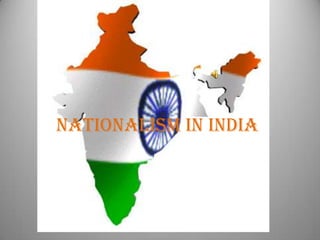
India and nalism
- 5. The following is a translation of Rabindranath Tagore's rendering of the stanza: Thou art the ruler of the minds of all people, dispenser of India's destiny. The name rouses the hearts of Punjab, Sind, Gujarat and Maratha, of the Dravid and Orissa and Bengal; it echoes in the hills of the Vindhyas and Himalayas, mingles in the music of the Yamuna and Ganga and is chanted by the waves of the Indian Sea. They pray for thy blessings and sing thy praise. The salvation of all people is in thy hand, thou dispenser of India's destiny. Victory, victory, victory to thee.
- 6. • The National Emblem of India is a replica of the Lion of Sarnath, near Varanasi in Uttar Pradesh. The Lion Capital was erected in the third century BC by Emperor Ashoka to mark the spot where Buddha first proclaimed his gospel of peace and emancipation to the four quarters of the universe. • The four lions (one hidden from view) - symbolizing power, courage and confidence - est orn a circular abacus. • The abacus is girded by four smaller animals - guardians of the four directions: the lion of the north, the elephant of the east, the horse of the south and the bull of the west. • The abacus rests on a lotus in full bloom, exemplifying the fountainhead of life and creative inspiration. The motto 'Satyameva Jayate' inscribed below the emblem in Devanagari script means 'truth alone triumphs'.
- 7. Tiranga
- 9. SAFFRON: the top layer - this color signifies COURAGE and SELFLESSNESS. India has a history of brave and loyal freedom fighters. Saffron indicates the strength of this nation and its will to give away all for the benefit of its people. Saffron is also the color of cloth worn by Holy men of India since ancient times. WHITE: the middle layer - this color signifies PEACE and TRUTH. A nation with diverse ethnic and cultural groups. Rich history, 22 officially recognized languages and more than 300 dialects. Some people think there are only 15 official languages because the language panel on Indian rupee banknotes display the denomination of the note in 15 of the 22 official languages of India. GREEN: the Last layer - the color signifies PROSPERITY and FERTILITY. A country ahead in every field and industry. Has names and people known for their achievement all over the world, a country that gives the best brains and population to almost every other nations' success. A success that isn't shared by most. CHAKRA: the wheel in the center. Very well known as ASHOKA CHAKRA taken from the ASHOKA reign Pillar signifies Justice. The 24 Spokes signify 24 hours of a day.
- 12. The charkha was both a tool and a symbol of the Indian independence movement. The charkha, a small, portable, hand-cranked wheel, is ideal for spinning cotton and other fine, short-staple fibers, though it can be used to spin other fibers as well. The size varies, from that of a hardbound novel to the size of a briefcase, to a floor charkha. Mahatma Gandhi brought the charkha into larger use with his teachings. He hoped the charkha would assist the peoples of India achieve self-sufficiency and independence, and so used the charkha as a symbol of the Indian independence movement and included it on earlier versions of the Flag of India
- 14. Bankim Chandra Chattopadhyay & Bharat Mata The identity of the nation is most often symbolized in a figure or image. This helps create an image with which people can identify the nation. It was in the twentieth century, with the growth of nationalism, that the identity of India came to be visually associated with the image of Bharat Mata The image was first created by Bankim Chandra Chattopadhyay.
- 15. Abanindranath Tagore & Bharat Mata Abanindranath Tagore painted his famous image of Bharat Mata. In this painting Bharat Mata is portrayed as an ascetic figure; she is calm, composed, divine and spiritual. In subsequent years, the image of Bharat Mata acquired many different forms, as it circulated in popular prints, and was painted by different artists. Devotion to this mother figure came to be seen as evidence of one’s nationalism.
- 16. Vande Mataram
- 18. FLAG
- 19. The tricolour, officially adopted as the national emblem by the Congress . The flag then unfurled had a band of deep saffron to symbolize courage and sacrifice, a band of white imprinted with a blue charkha for truth, and a band of dark green for faith and chivalry. On July 22, 1947 three weeks before Indian Independence, the Constituent Assembly adopted the tricolour as India's National Flag, but replaced the charkha with the Asoka Chakra, which appears on the abacus of the Lion Pillar at Sarnath.
- 25. Powerpoint Templates Page 25
